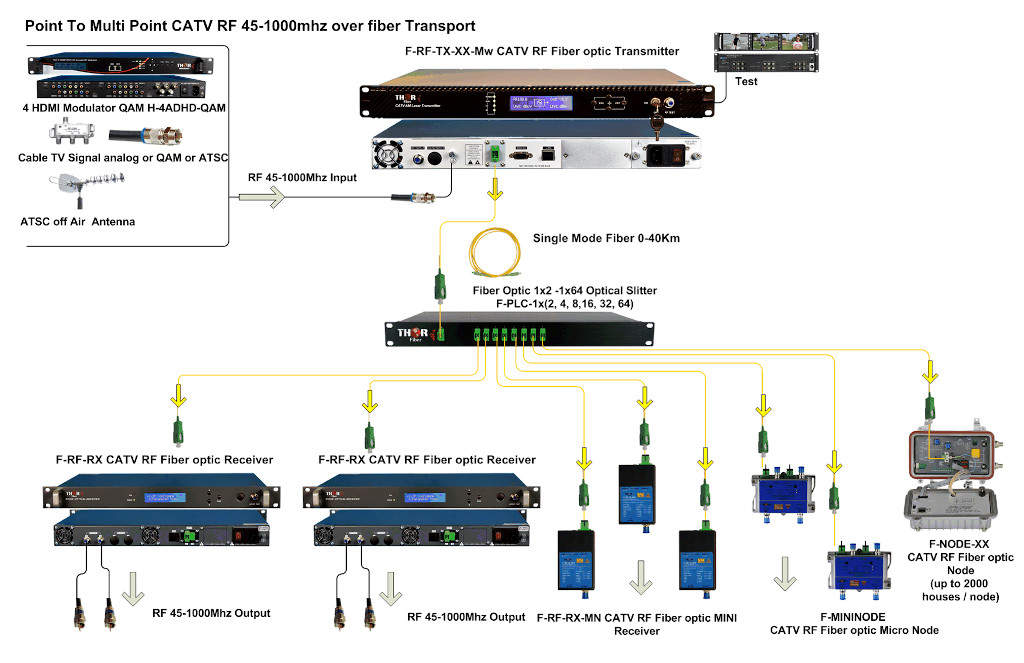Traditional cable television systems face growing pains in catering to the high-quality video demands of today's consumer. The revolutionary change that has taken place within cable television distribution, particularly with the advent of CATV over fiber, has been with the transition of coaxial cable systems to fiber optic technologies.

Technology Behind CATV Over Fiber
CATV over fiber systems rely on several key components, including:
Fiber Optic Transmitter: This transmitter converts the RF signals, normally traveling along coaxial systems to optical signals that can run along fiber optic cables.
Optical Converter: The optical converter may be used to ensure proper RF-to-optical conversions and vice-versa for compatibility within the system.
Optical Receiver: Finally, optical receiver converts these optical signals back into RF to distribute over televisions and similar equipment.
RF Optical Transceiver: Capable of sending and receiving data, RF optical transceivers make the CATV over fiber architecture less cumbersome.
These fitted in one gadget allow CATV over fiber to efficiently provide good quality television services to its customers.
CATV Over Fiber: Advantages
Higher Throughput: One of the major advantages of CATV over fiber is the fact that it offers substantially higher throughputs compared to coaxial-based CATV systems. Fiber optic cables have the capability to carry enormous volumes of data and are ideal for the delivery of numerous HD and UHD channels all at the same time.
Fiber versus Coax: When it comes to the debate between fiber and coax, fiber optics are much more capable with regard to data capacity. Coaxial cables are good enough for standard-definition broadcast but can't support high-bandwidth applications that are used today. In a world where streaming services and on-demand content grow very fast, the requirement of a robust method to accommodate such demands is what makes CATV over fiber such an enticing proposition.
Quality of Image: This transition to fiber optics also leads to better image qualities for the viewer. Optical fibers are resistant to electromagnetic interference that usually degrades the signal in coaxial systems. Due to this, CATV over fiber offers a more clear and stable video signal, improving the overall viewing experience.
Coaxial Cable vs Fiber Optic
These advantages of fiber versus coaxial cable can be more pronounced in situations involving high demand, such as live sports broadcasts or major events in RF venues. In any case, reliability with fiber optics ensures that viewers will see uninterrupted, high-quality signals irrespective of the conditions around them.
Long-Distance Transmission: This is another critical advantage of CATV over fiber: it allows the distance to be covered by the signals with much more significant lengths without the loss of quality. Coaxial cables have limitations on the distance over which they can carry the signals effectively; they often require amplifiers and repeaters. On the other hand, optic fibers can transmit signals for many kilometers without much attenuation.
This capability makes fiber optics an ideal solution for large-scale cable television networks spanning across wide areas. CATV over fiber will, therefore, enable operators to serve remote areas without sacrificing the quality of service-a very crucial factor in customer satisfaction.
Cable Infrastructure Future-Proofing: Technology is bound to evolve; hence, the requirements of higher speeds and more bandwidth will keep increasing. Transitioning to CATV over fiber technology future-proofs the infrastructure investment of cable operators by easily allowing upgrades and new services with lesser major overhauls of the system involved.
RF Over Fiber and RF Over Glass: Other technologies, such as RF over fiber and RF over Glass, further exhibit the flexibility of fiber optics. Moreover, cable operators are also capable of effectively providing high-definition video with high-speed internet and other services in parallel by integrating these technologies. This again ensures the flexibility inherent in cable networks, which keeps them competitive in an ever-changing marketplace.
Cost-Effective in the Long Run
This will also go a long way with coax to fiber converters, which will enable operators to upgrade their networks without necessarily overhauling them. The hybrid approach would thus enable cable providers to exploit some of the advantages offered by fiber optics while still leveraging their existing infrastructure-smoothing investment in the process.
Practical Applications of CATV Over Fiber
The applications of CATV over fiber are varied and many:
Television Distribution: Fiber optic networks that supply HD and UHD content to consumers' homes with the best quality.
Live Event Broadcasting: Live RF venues that are broadcast with robust, high-quality signals for live events so that the audience gets a great view of what happens.
Internet Services: Most cable providers have begun offering internet services along with cable television and are now taking advantage of the great speeds of fiber to provide faster broadband connections.
Including optical audio converters along with video services will give an enhanced audio experience and further enrich the viewer's viewing experience.
CATV over fiber is considered a leap forward in technology relating to cable television. By integrating fiber optics with existing coaxial infrastructures, cable operators can utilize higher throughputs, enhance picture quality, and transmit over longer distances, making the network future-proof. In fact, the need for high-definition content and dependable services does increase the pressure of having CATV over fiber in the near future. The question currently lying in the minds of fiber vs coax will apparently lean more towards the former while adaptation is made to modern demands that ensure the best viewer experience in their homes. In short, investment in the CATV over fiber technology significantly enhances the current offerings while simultaneously positioning the cable operator for the next generation of telecommunications.

 ES
ES


